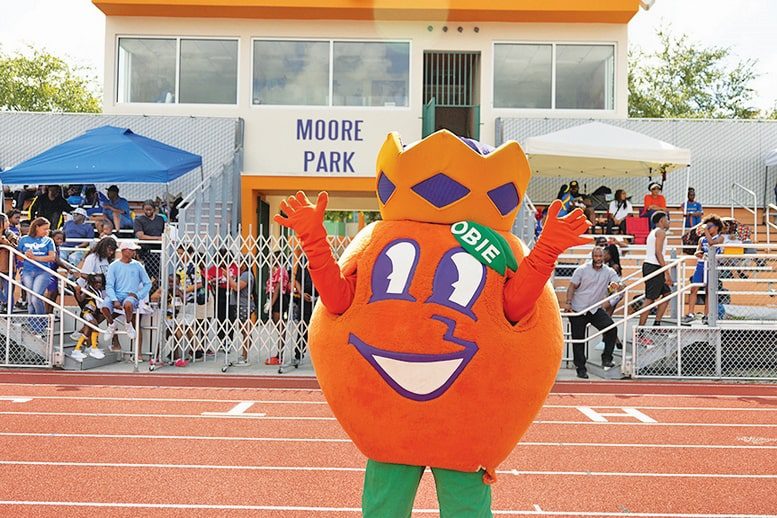Thousands of apartments may rise on old Miami Arena site
Advertisement

A vast and towering mixed-use residential development would give new life to the long-vacant former Miami Arena site in the heart of downtown.
WG 700 NORTH MIAMI LLC, owner-developer of the property at 721 NW First Ave., plans a phased project to include up to 2,346 rental apartments, ground floor retail, amenities, and parking for about 2,078 cars.
The design provides three separate towers above the eighth amenity level, with the maximum height 54 stories.
The city’s Urban Development Review Board unanimously recommended approval, with one suggestion.
The site has been vacant land since the Miami Arena, built in 1988 as home to the Miami Heat and the Florida Panthers, was demolished in 2008. Both teams had left the building in the late 1990s for newer venues.
The new project, 700 NMA, is to have 3,379,131 square feet of floor area.
Melissa Tapanes, an attorney representing the owner-developer, said the 4.7-acre property is on the east side of Northwest First Avenue, between Northwest Eighth and Sixth streets.
In a letter to the city, she offered a history of the high-profile site.
The Miami Arena Development of Regional Impact (DRI) was adopted by the City Commission on March 31, 1987. The DRI approved development of a 300,000-square-foot, 15,000-seat arena for basketball and other uses (concerts, events, etc.), along with other site improvements, she said.
Ms. Tapanes said the new project will have all parking and loading spaces on site.
“The southwest side of the property, abutting the existing railroad track, will be improved with a beautiful, well-landscaped green space. With this much-needed urban outdoor space, the project provides 36.38% open space when only 10% is required,” she wrote.
“To minimize the overall massing and improve operation between the variety of proposed uses, the design strategically provides three separate tower structures above the eighth amenity level. The maximum proposed height of the project is 54 stories. The property is an irregular-shaped lot without rear access. The project strategically provides access for vehicles and pedestrians from the three frontages,” Ms. Tapanes wrote.
She said the project provides a place where people can reside, work, and carry out the other activities of daily life, such as shopping, recreation, and entertainment, all within comfortable walking distance.
Although construction is anticipated in three phases, the applicant submitted the project as a single unit for the purpose of calculating all zoning requirements, said Ms. Tapanes.
The owner-developer is seeking waivers to allow:
■A 22-foot-wide driveway when 23 feet is required.
■A 19,800-square-foot residential building floorplate when 18,000 is permitted.
■A 198-foot-long building when 180 feet is permitted.
■Substitution of commercial loading berths with residential loading berths.
■A 33-foot-wide parking garage entrance when 30 feet is the most permitted.
■Up to 2,121 bicycle parking spaces when 2,357 are required, a 10% reduction.
Ms. Tapanes told the review board the old arena site has an irregular shape and is bordered on the south by the FEC railroad tracks. She noted the site is adjacent to the new Brightline passenger rail station, a Metrorail station, and “Miami Worldcenter abuts to the east.”
Project architect Kobi Karp described the plan in detail.
“We have an opportunity on the site to really make it more porous and continue the Seventh Street pedestrian and vehicular circulation through the site,” he said. “Kimley-Horn worked to bring the green space and public space into the site to make it more porous, make it accessible.”
The project “allows us more open space. We have an opportunity to create a block accessible to pedestrians and vehicles, the public and community, those who live in the neighborhood,” he said.
Board member Fidel Perez said, “I think there’s a lot of positive things about the project, the liner you have created and the podium … and the difference between the podium and the building was a great idea.”
He added, “The problem with this project is that it’s a massive project, you know, it’s going to create a lot of traffic movement.”
Mr. Perez asked if the developer was building all the residential units allowed. Ms. Tapanes said the number is approaching the maximum but won’t exceed the limit.
She said, “This is where density should occur. It is a large number of units, but it is 4.7 acres of land, with over 38% as open space,” and the site is adjacent to mass transit.
Mr. Karp said, “We’ve created a pocket park along the railroad tracks. It’s where the trains slow down as they come around so we thought there is an opportunity to create a pedestrian path along the railroad tracks … and here you can see we’re really focusing to keep our drop-off inside and open it up to the public.”
Board member Gia Zapattini asked what would happen to phase two and three while phase one is being completed.
Mr. Karp answered, “We’re hoping they will come online at the same time.”
Board member Anthony Tzamtzis asked the type of residential use. Ms. Tapanes said it’s proposed as a rental project.
Acting Chairman Agustin Barrera said, “Architecturally the project is very elegant, and one of the challenges with a site this big is how to get so many units and not overcrowd the site.
“I like the vehicular circulation. I like the pedestrian circulation. I think it’s inevitable that you’re going to have to cross some driveways with pedestrian circulation…
“I like that you separated the vehicular access ramps from the loading area. Some other parties are kind of combining them, which creates challenges,” he said.
The motion to approve the project included a recommendation from Ms. Zapattini to make sure there is pedestrian connectivity internally all the way from the Metrorail to North Miami Avenue.

